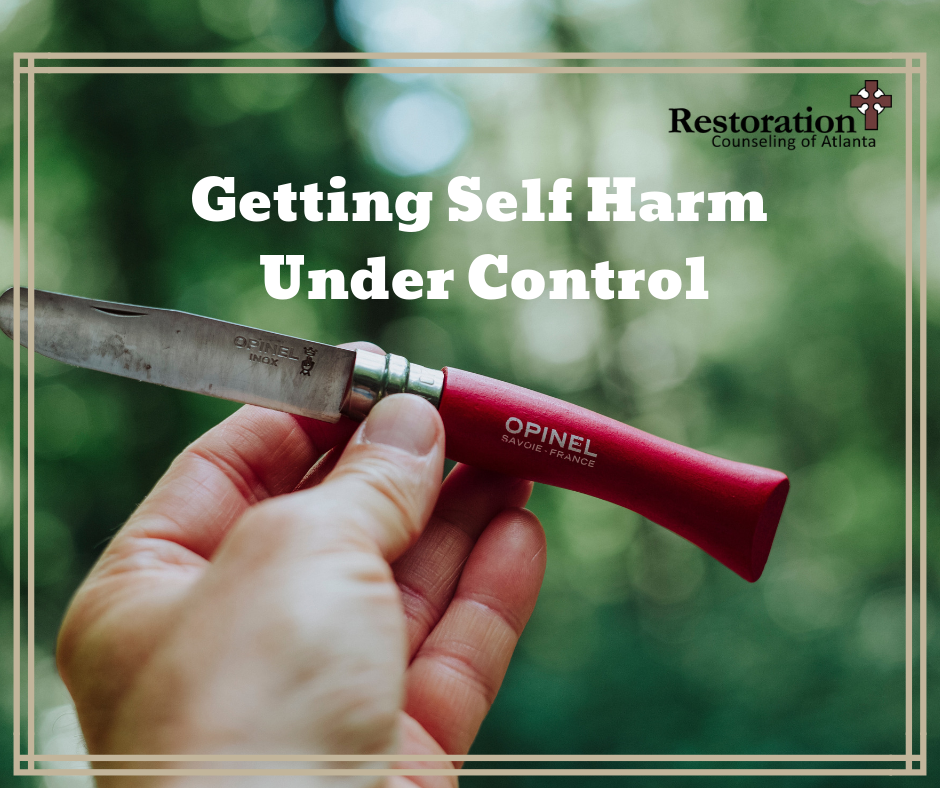How Parents Can Help
Ever noticed someone with multiple cuts on their arms or legs and wondered what happened to them? Or thought it strange that the kid next door was wearing long sleeves and jeans on a ninety degree day? There is an alarming trend among teens to participate in self-harming behavior as a means of coping with pain and has many parents wondering how they can recognize if their child is in trouble and help them stop hurting themselves.
Learning about Self-Harming Behavior
Obvious self-harming behavior is when people:
- cut themselves,
- burn themselves,
- bite themselves,
- pull their hair out (hair, eyebrows, eyelashes),
- swallow too many pills,
- interfere with wound healing,
- inserting objects into the skin,
- stab themselves, or
- bang their bodies against a wall.
Less obvious means can be:
- overspending,
- gambling,
- substance abuse,
- promiscuity,
- shoplifting,
- reckless driving,
- binge eating,
- purging, or
- other ways to cause harm in their lives.
Self harm Behavior is not a suicide attempt. When someone self-injures, there is no intent to die, unlike a suicidal person. A suicidal person is trying to escape pain, but Self Harm Behavior is used to control the pain. In fact, the pain reassures the person that they are still alive, whereas a suicidal person has no hope that life will get better. If someone self-harms to the point of death, it is usually an accident. However, suicide attempts and self-mutilation behaviors do correlate, with those who have self-harmed being much more likely to attempt suicide or have a plan for suicide.
Why do people do it?
They do not do it for attention! For some, it is a way to release internalized pain in a way that gives them control over the rampant hurting they feel, while others use it as a form of self-punishment for some perceived shortfall. Others start doing it to attain group membership, though that is a smaller percentage of people, while still others suffering from untreated depression and other mental health challenges live in an environment of despair that leads them to cope with these challenges in unhealthy ways.
In other words, they feel lost, angry, worthless, lonely, depressed, dead, sad, helpless, or/and hopeless. But the pain from SHB makes them feel alive, can numb the internal pain, or have other effects. It helps them feel better for a short period of time, like a sort of drug, and they do get addicted to it after a while.
Discover the warning signs
It can often be hard to spot the signs of self-harm, as many people will try to keep them hidden. Sometimes you will notice unexplained injuries but often it is changes in normal behavior that you see. These include:
- wearing long sleeve clothes in hot weather,
- avoiding swimming or other activities that require more exposure,
- hiding clothes or washing separately,
- being secretive about feelings,
- strange excuses for injuries or frequent “accidental” injuries (for example, a pet owner says scratches on arm are from the cat), or
- changes in eating, sleeping and communication.
More obvious signs include questionable and numerous scars from cutting or burning, the presence of sharp objects, like razorblades or other instruments used to self injure, and broken bones or bruises from banging or punching.
There are other risk factors for parents to be aware of as well. For one, the “Goth” culture commonly accepts SHB, and kids involved in the Goth movement are looking for acceptance in an alternative culture. However, just because a child is involved in the Goth culture, it does not necessarily mean they self-injure. Sometimes self-injury starts out as a defense mechanism against what is happening in the family or in their life and then becomes a method to gain control, such as when there is a divorce or death in the family. Many who self-harm are sensitive, perfectionists, or overachievers, and it is not unusual for teenagers with an eating disorder, like anorexia or bulimia, to be involved with self-injury. Finally, having a history of physical, sexual, or psychological abuse also increases the risk for Self Harm Behavior.
How Can You Help?
Self-injury discovery or disclosure can come as a complete shock if you are on the receiving end. Your reactions to self-injury disclosure, though, are important. Remember that SHB can be a cry for help due to intense and unbearable emotions. Horror is the last thing they need for you to express. Appreciate that to confess to something such as self-injury is a very big step for someone, and they are extremely worried about the reactions they will get from people if they “come out” about their problem. Therefore, if they do confess, it is likely that they trust you because they will only confide in someone they trust.
The best way to respond is to:
- remain calm and caring,
- accept him or her even if you disagree with the behavior,
- know that this represents a way of dealing with emotional pain,
- listen with compassion, and
- avoid panic and overreaction.
- Do not show shock or revulsion at what they have done.
- Do not use threats in an attempt to stop the behavior.
- Do not allow him or her to recount the self-injury experience in detail as it may trigger another session.
- Do seek medical and mental health attention from your Primary Care Physician, Inpatient/Emergency Care if in Crisis, Partial Hospitalization (PHP) or Intensive Outpatient Programs (IOP), or an outpatient therapist.
- Do talk about self-destructive behaviors, being careful to be non-judgmental by expressing support, not anger, shaming, or guilt. Identify the behavior as a problem that needs to be fixed, and sit with them to weigh options that can help them.
- Do make the environment safe by removing any objects that could be used to self-harm and avoiding places where they are more likely to self-harm when they have the urge.
- Teach positive coping skills such as seeking out and being with other people when urges strike, how to delay self-harming until the urge has passed, using a “distraction box” filled with items that require concentration (book, toy, puzzle, coloring, etc.), journaling, exercising, playing video games, playing or listening to music, or doing relaxation techniques.
- Teach them to work through their emotions. Many have bottled up or numbed their feelings, so crying or just talking to an empathetic listener will bring relief and curb urges to self-harm. This can be a trusted friend or family member, a therapist, or even a helpline.
Finally, parents can help their child who is self-harming by:
- modeling & teaching effective coping skills or enroll them in a DBT skills group,
- helping your teen identify and set appropriate boundaries with unhealthy friends,
- utilizing discipline strategies that teach responsibility and self-reliance to build self-worth, and
- having family meetings to promote expression of feelings and family cohesion.
Most importantly, be patient with them!
Remember that they are doing hard work trying to change habits instead of taking a quick and easy way out of their pain. Your support and understanding are crucial to their success.
Hotlines/Helplines
- Text “LIFE” to 61222 for help with self-harming urges
- Self Harm Text Hotline – Text CONNECT to 741741 in the US.
- Self-Harm Information and Referrals: 800-DONT-CUT (366-8288)
- Parent Support Network: 800-832-8645
- Parent to Parent: 800-229-2038
- Self-Injury Outreach and Support
 by Paige Santmyer, MA APC NCC CCATP
by Paige Santmyer, MA APC NCC CCATP
Roswell location
paige@restorationcounselingatl.com, ext. 157
Paige provides a safe and comfortable atmosphere where clients can explore the challenges they are facing. She also believes in addressing the individual’s entire personhood, assessing needs in all domains of life instead of focusing solely on mental health needs. Paige works with adults and teens around depression, anxiety, mood disorders, relationship issues, trauma, PTSD, and life transitions.

